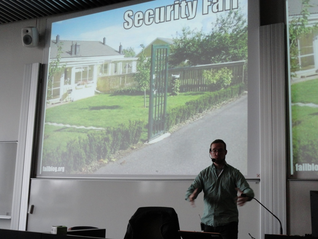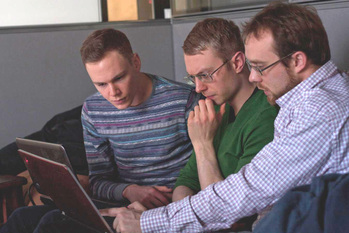Hacking courses

I taught a popular course on advanced practical security and exploitation through the attacker's lens between 2011-2022. When it comes to cybersecurity, I believe that the best way to implement defense is through understanding offense. I gave a TEDxReykjavik talk in 2014 and a follow-up at TEDxReykjavik 2019 explaining my philosophy in more detail.
Several times, we have the associated IceCTF hacking contests with the course that have been remarkably well received by the public and the media (RUV TV news, RUV Radio 2, Kastljós (Spotlight), Stöð 2/Vísir, MBL Morning Newspaper, MBL Morning Newspaper, MBL Morning Newspaper, Stöð 2/Vísir, Nord Nordursins, RUV Radio 2, Vocativ (on Syndis)). A unique feature of the early contests is that they are not just fun and educational for the participants, but also entertaining for the audience.
I have released all of my security lectures on my YouTube channel.
Several times, we have the associated IceCTF hacking contests with the course that have been remarkably well received by the public and the media (RUV TV news, RUV Radio 2, Kastljós (Spotlight), Stöð 2/Vísir, MBL Morning Newspaper, MBL Morning Newspaper, MBL Morning Newspaper, Stöð 2/Vísir, Nord Nordursins, RUV Radio 2, Vocativ (on Syndis)). A unique feature of the early contests is that they are not just fun and educational for the participants, but also entertaining for the audience.
I have released all of my security lectures on my YouTube channel.
Network science

Multiple fields, including computer science, political science, physics, epidemiology, biology, ecomics and social science, have independently tackled surprisingly related problems in the past, but are now joining forces to create a new science of the structure of large real-world networks.
I have periodically taught a course on network science that studies the connectness of our social, technological and biological worlds through the lens of graphs and networks based on the book Networks, Crowds and Markets by David Easley and Jon Kleinberg.
The course explores how people are connected in social networks; how opinions, disease and political activism spreads through society; how communities form and can be inferred from data; theories underlying strong and weak ties in relationships; ranking of the web hyperlink graph (PageRank), and various other topics. Students study models and theories to help explain and exploit the structure of information and social networks, and tools to facilitate the analysis of these networks.
The course materials for the 6-week 2011 (Reykjavik University) version and 15-week 2015 (Emory University) version are available online.
I have periodically taught a course on network science that studies the connectness of our social, technological and biological worlds through the lens of graphs and networks based on the book Networks, Crowds and Markets by David Easley and Jon Kleinberg.
The course explores how people are connected in social networks; how opinions, disease and political activism spreads through society; how communities form and can be inferred from data; theories underlying strong and weak ties in relationships; ranking of the web hyperlink graph (PageRank), and various other topics. Students study models and theories to help explain and exploit the structure of information and social networks, and tools to facilitate the analysis of these networks.
The course materials for the 6-week 2011 (Reykjavik University) version and 15-week 2015 (Emory University) version are available online.